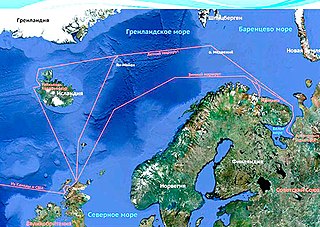Top Qs
Timeline
Chat
Perspective
Operation Doppelschlag
1942 German plan From Wikipedia, the free encyclopedia
Remove ads
Operation Doppelschlag (Operation Double Blow/Unternehmen Doppelschlag) was a German plan for a sortie in 1942 during the Second World War into the Arctic Ocean by the Kriegsmarine. The operation followed Unternehmen Rösselsprung, against Convoy PQ 17 in July 1942 to attack Convoy PQ 18 the next Arctic convoy of the Western Allies.
Remove ads
Background
Following the victorious operation against Convoy PQ 17 (27 June – 10 July 1942), the Kriegsmarine was keen to repeat the success. A plan was made to bring a powerful force of cruisers and destroyers against the next PQ convoy to destroy it. The Allies wished to avoid running another convoy in the continuous daylight of the Arctic summer and deferred passage of Convoy PQ 18 and its reciprocal Convoy QP 15 until later in the year. The German forces spent over two months at readiness before the convoys sailed in early September 1942.
Remove ads
Plan
Summarize
Perspective

Russian map showing Arctic convoy routes from Britain and Iceland, past Norway to the Barents Sea and northern Russian ports
A patrol line of U-boats (Wolfpack Eispalast (Ice Palace) was stationed in the Norwegian Sea to give early warning of a convoy. The ships of Unternehmen Doppelschlag would be waiting in readiness at their bases. Once the convoy was detected the ships would sail north to Altafjord and wait. The risk of losing a capital ship in an engagement with the Allied fleet meant that only Hitler could give permission for the second stage, the sortie into the Barents Sea. Once out the ships would divide into two battle groups to attack the convoy from different sides.[1]
It was envisaged that the first group would engage and draw off any big ships with the convoy and the second group would attack the merchant ships while their escorts were distracted. It was this intended double blow that inspired the operational name. The ships intended to take part in the operation were the Admiral Scheer, Admiral Hipper, Köln and six destroyers. Other German capital ships in Norway, Tirpitz and Lützow were not available for the operation as both had been under repair since the end of Rosselsprung.[1]
Remove ads
Operation
Convoy PQ 18 sailed from Iceland on 7 September 1942. It was sighted on 8 September by a long-range reconnaissance aircraft and again on 10 September by an Ice Palace U-boat. On 10 September, the ships of operation Doppelschlag departed Narvik to move north to Altenfjord. The German ships were sighted by British submarines and Tigris mounted an abortive attack.[2] The ships arrived at Altenfjord early the following day. The Doppelschlag commanders, Vice-Admiral Oskar Kummetz in Scheer, and Vice Admiral Otto Ciliax ashore, pressed for permission to sortie but Hitler's insistence that no damage should befall the ships so restricted their freedom of action that Admiral Erich Raeder, the Navy's supreme commander, cancelled the operation.[3][4] The attack on Convoy PQ 18 was left to the Luftwaffe and the U-boat arm.
Aftermath
Summarize
Perspective
Analysis
The German surface fleet had little effect on the passage of Convoy PQ 18, though its latent threat forced the commitment of many Allied vessels to Operation EV, the escort operation. The British thought that the failure of the German ships to attack Convoy PQ 18 was caused by British measures to defeat a sortie. In his report, Admiral Tovey wrote that the German ships remained at Altenfiord for several reasons. The strength of the fighting destroyer escort acted as a deterrent, the presence of British submarines off the Norwegian coast, German knowledge of Operation Orator, the Search and Strike Force of torpedo-bombers based at Vaenga, the continuous reconnaissance by RAF aircraft of the German anchorages and the awareness of the Home Fleet heading north-east on 12 September.[5]
In 1977, the British historian Peter Smith wrote that the German decision not to commit the ships to an attack on Convoy PQ 18 had been taken weeks before the convoy sailed based on the German analysis of the operation against Convoy PQ 17. The Luftwaffe claimed the sinking of a cruiser, a destroyer, two escort ships and 22 merchant ships and the U-boats claimed 16 ships of 113,963 GRT and cut the Luftwaffe total to twenty ships and 131,000 GRT. Colonel-General Hans-Jürgen Stumpff, the commander of Luftflotte 5, claimed that his aircraft has sunk 142,216 GRT of shipping but Convoy PQ 17 lost eight ships to air attack, nine to U-boats and seven to attacks by both. The Germans did not know that the convoy had been scattered against an attack by ships; the Luftwaffe thought that its attacks had caused the convoy to scatter and this mistaken impression affected later German plans.[6]
Subsequent operations
The next opportunity for an attack by German surface ships came in December, when Unternehmen Regenbogen (Operation Rainbow), following a similar plan to Doppelschlag, was mounted against Convoy JW 51B, leading to the Battle of the Barents Sea.[7]
Remove ads
German order of battle
Ships
U-boats
Remove ads
Footnotes
Bibliography
Further reading
Wikiwand - on
Seamless Wikipedia browsing. On steroids.
Remove ads

